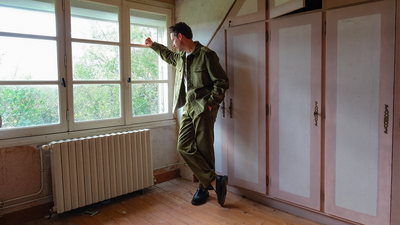For years, De Bonne Facture has been committed to reviving this local industry through being one of the founding members of the Tricolor Collective, bringing together shepherds, breeders, spinning mills, weavers and creatives, to revive our local wool industry. This is part of an approach to rebuilding the local raw material sectors in which we are very involved, in a context where they have been damaged by the deindustrialization and relocation of the last thirty years, both in the wool and linen industries.
Thus, during our research and our meetings with wool craftsmen and spinners, weavers, and breeders, we chose wools from regional breeds of French sheep, carefully selected for their natural colors, without the addition of dyes, as the use of certain conventional dyes can have a significant environmental impact.
In particular, the undyed wool yarns of our ebony colored grandad trench coats come from a breed of sheep from Auvergne in France, the "Noire du Velay". They are spun and woven locally in the historic region of Mazamet, by the Filature du Parc atelier & by Eric Carlier of the Passe-Trame atelier. The latter was a pioneer in the introduction of angora goats in France and supplied the cooperatives of breeders in the region. The retirement of a weaver friend led him to acquire industrial looms. Nevertheless, most of his production is still done on an artisanal scale with many manual steps and a real passion that he dedicates to his know-how.
We also offer a selection of sweaters in genuine Arles merino wool in colors that are also undyed and spun by Filatures du Parc. With its 65 years of existence, this spinner, a company located in the Tarn, has acquired a recognized and appreciated technique and know-how in the manufacture of classic carded yarn from various French wools, including the Arles merino wool.
From a historical point of view, merino sheep originate from North Africa and more particularly from Morocco. Indeed, the term "merino" is linked to the Berber dynasty of the Merinids who ruled over certain parts of the Maghreb and the Iberian Peninsula in the 14th century.
From a historical point of view, merino sheep originate from North Africa and more particularly from Morocco. Indeed, the term "merino" is linked to the Berber dynasty of the Merinids who ruled over certain parts of the Maghreb and the Iberian Peninsula in the 14th century.
The use of this wool in France is traced to the XVIIIth century. In order for French manufacturers to obtain softer and more refined fabrics, Louis the XVIth brought merino sheep from Spain to crossbreed them with French merino sheep. These cross breedings made the wool fleeces of the Merino sheep finer and therefore softer, giving birth to a new breed of sheep: the Merino sheep of Arles.
We are pleased to be part of an exhibition dedicated to the history of merino sheep at the Museum of National Archives from December 15, 2021 to April 18, 2022, where some De Bonne Facture pieces are exhibited.





